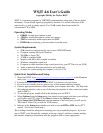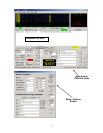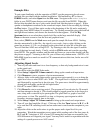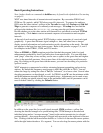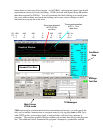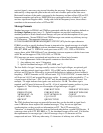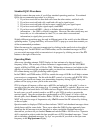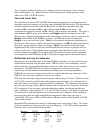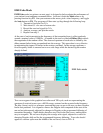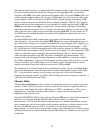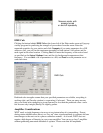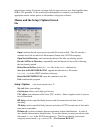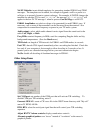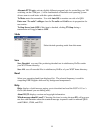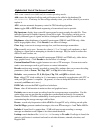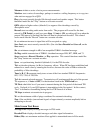
You will need a method of setting your computer clock to an accuracy of one second or
better, and keeping it set. Many operators use an internet clock-setting program, while
others use a GPS or WWVB receiver.
Solar and Lunar Data
The light blue text box in JT65 and EME Echo mode presents data for tracking the moon,
measuring sun noise, tuning your receiver, and evaluating EME path losses. The information
includes azimuth and elevation (Az and El) for the sun and those quantities plus right
ascension (RA), declination (Dec), and local hour angle (LHA) for the moon. All
coordinates are in degrees except for RA, which is given in hours and minutes. The moon’s
semi-diameter (SD) is given in arc minutes, and Doppler shift for the band in use in Hz.
Since two-way Doppler shift depends on the other station’s location as well as your own, the
Doppler field is blank if the Grid box is empty. In EME Echo mode, the displayed
Doppler is your own self-echo value. Tsky gives the galactic background temperature in
the direction of the moon, scaled to the operating frequency, and dB the added signal loss at
the moon’s present distance, relative to perigee. Dgrd is an estimate of the total signal
degradation in dB, relative to the best possible time when the moon is at perigee and in a
cold part of the sky. Click with the mouse anywhere in the light blue text box to see the
local coordinates (Az and El) of the moon at the DX station’s location and the maximum
non-reciprocity of the EME path, in dB. Click again to toggle back to the normal display.
Distinctions between the Submodes
Messages are encoded differently in the three FSK441 submodes, so a transmission in one
mode must be decoded using the same mode. FSK441A uses a zero-redundancy code in
which characters are transmitted with three successive tones, each at one of four assigned
frequencies. The FSK441B and C modes use sequences of four and seven tones,
respectively, with the additional information providing error-correcting capabilities.
FSK441B can correct any single error in the four symbols that make up a character, while
FSK441C can correct up to three errors in seven symbols.
JT65 transmits messages using 65-tone frequency-shift keying at 2.7 baud. The lowest tone
at 1270.5 Hz is used to establish time and frequency synchronization; it is switched on for
half of the time, according to a pseudo-random on-off pattern. The remaining tone intervals
carry the user message, using a Reed-Solomon code for forward error correction. The three
JT65 submodes all use the same code and modulation scheme, but the spacing between
tones is different—approximately 2.7, 5.4, and 10.7 Hz for modes A, B, and C, respectively.
A transmission in one submode must be received in the same submode. If the equipment
and propagation path are stable enough that the measured width of the sync tone is
consistently 4 Hz or less, JT65A will be about 1 dB more sensitive than mode B and 2 dB
more sensitive than C.
Shorthand JT65 transmissions consist of alternating tones, each lasting 1.486 s. The lower
of the two frequencies is always at the sync-tone frequency, 1270.5 Hz, and the separation
between tones is given in the following table:
Message JT65A JT65B JT65C
ATT 26.9 Hz 53.8 107.7 Hz
RO 53.8 107.7 Hz 215.3
RRR 80.8 161.5 323.0
73 107.7 215.3 430.7
8



